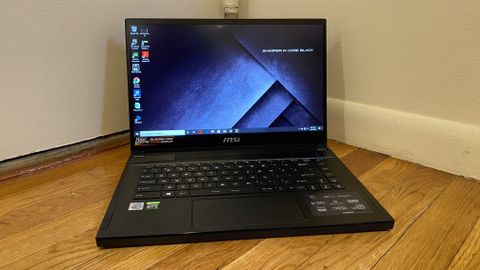Tom's Hardware Verdict
The MSI GS66 Stealth has the looks of a flagship with strong gaming performance, but it runs hot and loud with so-so productivity power.
Pros
- +
Attractive, sleek design
- +
Strong gaming performance
- +
99.9 WHr battery
Cons
- -
Runs hot
- -
Middling productivity performance
- -
Very loud fans
- -
Odd function key placement
Why you can trust Tom's Hardware
As of late, gaming laptop makers have been on a bit of a white whale quest in their efforts to deliver the best gaming laptop. The idea? Make something powerful enough to compete with flagship rigs, but slim enough to look like it’s not a beefy gaming machine. With the MSI GS66 Stealth ($1,599 to start; $2,699 as tested), you get an all-black machine that’s thin and portable as far as gaming laptops go. It features up to a 300 Hz display, and, with a 10th Gen Intel Core i7-H series and Nvidia’s latest RTX Super Max-Q GPUs, but that’s a lot of power jam into a small space -- the laptop is just 0.7 inches thick -- and you can feel the heat.
Design





I’ll give the MSI GS66 Stealth this: It doesn’t look like your average gaudy gaming notebook. No, this is pure class -- at least as far as gaming notebooks go. The aluminum chassis on the GS66 Stealth comes in black this year (or as MSI calls it, “core black,” with the dragon shield logo in tone-on-tone black on the lid.
The 15.6-inch display is surrounded by three small bezels on the top and sides and a thicker one on the bottom.
On the black aluminum deck, there’s a dotted pattern up top for air intake above the keyboard. The keys are RGB-lit on a per-key basis, which you can customize in the SteelSeries 3 software. There’s also a large touchpad flanked on each side by slits for top-firing speakers. Notably, there’s no fingerprint reader or IR camera on the device, so be prepared to type your passwords.
On the left side of the laptop lives the port for the barrel charger, Thunderbolt 3 (which can be used for charging, but not to power the device while gaming), HDMI and USB 3.2 Gen 2 Type-A. On the right sits the 3.5mm headphone jack, USB Type-C, two more USB Type-A ports and an Ethernet jack.
At 4.6 pounds and 14.2 x 9.7 x 0.7 inches, it’s quite portable for a mid-sized gaming notebook. It’s not terribly surprising that the Gigabyte Aero 17 HDR, which is a 17-inch device, is heavier and larger at 5.5 pounds and 15.6 x 10.5 x 0.8 inches. The 14-inch Asus ROG Zephyrus G14 is 3.5 pounds and 12.8 x 8.7 x 0.7 inches. The Alienware m15 R2 is 4.9 pounds and 14.2 x 10.9 x 0.8 inches.
Specifications
| CPU | Intel Core i7-10750H |
|---|---|
| Graphics | Nvidia GeForce RTX 2080 Super Max-Q (8GB GDDR6) |
| Memory | 32GB DDR4-2666 |
| SSD | 512GB M.2 PCIe NVMe SSD |
| Display | 15.6-inches, 1920 x 1080, IPS-level 300 Hz |
| Networking | Intel Wi-Fi 6 AX201, Bluetooth 5.0 |
| Video Ports | HDMI |
| USB Ports | Thunderbolt 3, USB Type-C 3.2, 3x USB 3.2 Gen 2 Type-A |
| Audio | 2x 2W Dynaudio speakers |
| Camera | 720p webcam |
| Battery | 99.9 WHr |
| Power Adapter | 230W |
| Operating System | Windows 10 Pro |
| Dimensions (WxDxH) | 14.2 x 9.7 x 0.7 inches |
| Weight | 4.6 pounds (2.1kg) |
| Price (as configured) | $2,699 |
Gaming and Graphics




Our review unit came armed with an Nvidia GeForce RTX 2080 Super Max-Q, a powerful card that will let you play most games at their highest settings. I played a few rounds of Call of Duty: Warzone at the game’s highest settings at FHD, and it ran between 91 and 131 frames per seconds on the laptop. With the settings turned all the way down (in order to take advantage of a 300 Hz display), performance went as high as 204 fps, but usually was between 140 and 180 fps.
On the Shadow of the Tomb Raider benchmark (FHD, highest), the GS66 ran the game at 66 frames per second, surpassing both the Aero (RTX 2070 Super Max-Q, 61 fps) and the Zephyrus (49 fps, RTX 2060). It was beaten slightly by the Alienware m15 R2 (RTX 2080, 70 fps)
When it came to Grand Theft Auto V (FHD, very high), the Stealth played at 82 fps, this time losing to the Zephyrus. Part of that may be due to the latter laptop’s powerful CPU, the AMD Ryzen 9 4900HS.
On Far Cry New Dawn (FHD, Ultra), MSI’s laptop played the game at 86 fps, easily surpassing the rest of the field.
The RTX 2080 Super in the Stealth also led on Red Dead Redemption 2 (1080, medium) at 49 fps, beating both the Aero and the Zephyrus.
To stress test the Stealth’s gaming performance, we ran Metro Exodus 15 times on a loop using RTX presets. The game ran at an average of 47.7 fps across the runs (only the first run was noticeably higher, at a bit over 48 fps). The CPU ran at an average speed of 4.2 GHz and an average temperature of 90.9 degrees Celsius (195.6 degrees Fahrenheit). The GPU ran at an average speed of 1,173.9 MHz and an average temperature of 66.6 degrees Celsius (151.9 degrees Fahrenheit).
Productivity Performance
With an Intel Core i7-10750H, the GS66 Stealth is an adequate multitasker, though we suspect that issues with cooling led to lower performance than some competing machines.

On Geekbench 4.3, the Stealth earned a score of 25,304, falling behind the Aero 17 HDR with a Core i7-10875H (29,222) and the ROG Zephyrus G14 with an AMD Ryzen 9 4900HS (30,181). The Alienware m15 R2 with a last-generation Intel Core i7-9750H came in last at 22,701.
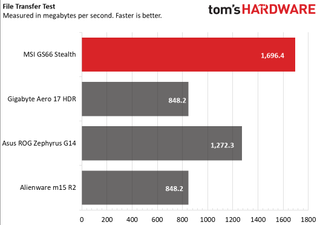
The Stealth took 3 seconds to copy 4.97GB of files, a rate of 1,696.4 MBps. That’s faster than the Zephyrus (1,272.3 MBps) and both the Aero and the Alienware (both 848.2 MBps).
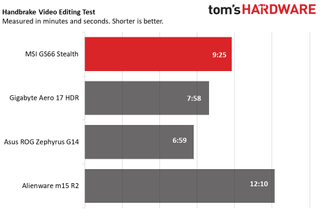
It took the Stealth 9 minutes and 25 seconds to transcode a 4K video to 1080p on our Handbrake test. That’s behind the Aero 17 (7:58) and Zephyrus (6:59), but faster than the Alienware (12:10).
Display
The 15.6-inch FHD display on our review unit is clocked at 300 Hz, which will appeal to some esports gamers with excellent reflexes who don’t want to miss a single frame. It’s not the brightest or most vivid of our test pool, but is absolutely serviceable. To start, I watched the trailer for Artemis Fowl, which showcased lush green forests and wasn’t too dark to show detail in its many scenes set in shadow. The display never tore while I played Call of Duty: Warzone.
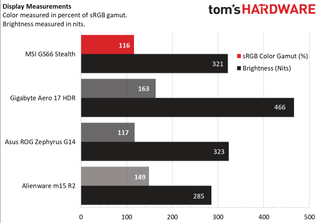
The display measured an average of 321 nits of brightness, just below the Asus ROG Zephyrus G14 and far behind the Aero 17 HDR’s 466-nit screen. The Alienware m15 R2 was the dimmest at 285 nits.
MSI’s panel covers 116 percent of the sRGB color gamut, almost tied with the Zephyrus, but behind both the Alienware and the Aero.
Keyboard and Touchpad


The keyboard on the GS66 Stealth is yet another partnership between MSI and SteelSeries. I largely found typing on it to be comfortable, but it has some oddities: the space bar is a bit looser and easier to press down than every other key on the keyboard, which was off-putting. Additionally, the right shift key is a bit short for my liking, and it appears it was made that way to allow for the arrow keys to fit in with the page up and page down keys. Finally, there is only one function key, and it’s a half-sized button shared with the right control key.
On the 10fastfingers.com typing test, I finished at 99 words per minute, which is a few behind my regular speed, albeit with similar accuracy.
The keyboard has per-key RGB lighting that can be controlled in the SteelSeries Engine 3 software
The touchpad measures 4.1 x 2.7 inches and is nice and spacious. With Windows precision drivers, it’s accurate and responded well to gestures and navigating the OS.
There’s only one feature that I felt the GS66 was missing here: a fingerprint reader. The webcam, however, works with Windows Hello, if you want a biometric login option.
Audio
One big change to the Stealth generation over generation is that it features two top-firing speakers this time around.
These things get loud -- with a capital “L.”. If you have the volume turned up past 60%, the audio can feel like a punch in the face. When I listened to Dua Lipa’s “Break My Heart,” I was a bit worried my next-door neighbors were going to come knocking and complaining. In Call of Duty: Warzone, bullets rang out and I could clearly make out the voice off the team leader barking into my ear before I entered the gulag.
That said, while sound is detailed, it’s a bit lacking in the bass department. The Nahimic app has some options to adjust the sound, but I found it was at its best out of the box.
Upgradeability
Opening up the Stealth takes a bit of elbow grease. There are nine Phillips-head screws to be removed, and all but one of them are the same size (the odd one out, which is shorter, goes under the lip of the laptop).
The bottom of the chassis is clipped in tight. But with some patience and a prying tool, I was able to work my way around, release all of the clips and get the case off.
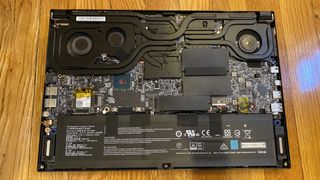
Interestingly, there are three fans as part of the cooling solution (most use two). On the one hand, that makes sense, as this laptop is powerful, thin, and gets quite hot. The trio of fans also explains why this thing sounds like it’s about to take off while you’re gaming.
The RAM and SSD are easily accessible under some heat shielding. Our review unit had both SODIMM slots full. But there was a second PCIe M.2 slot that you could simply fill with another drive for more storage. Just note that the second drive slot only accepts PCIe drives, as opposed to the slot that was already filled, which also accepts SATA.
Battery Life
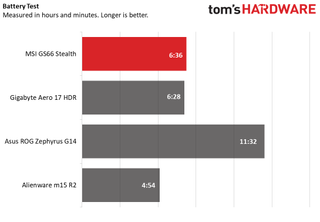
MSI crammed one of the biggest batteries we’ve ever seen in a laptop into the Stealth. At 99.9 WHrs, it’s bordering on the legal limit of what you can take on an airplane. (Remember airplanes?) While it lasts longer than many other gaming laptops, it’s not the longest-lasting one we’ve seen recently.
The GS66 Stealth endured for 6 hours and 36 minutes on our test, which continuously browses the web, streams video and runs browser-based OpenGL tests, all while connected to Wi-Fi and with a screen brightness of 150 nits. That edged out the Aero 17 HDR (6:28) and beat the Alienware m15 R2 handily (4:54). But the Ryzen 9 4900HS-powered laptop recently wowed us by running for over 11 hours on the test (we also ran several other battery tests on the Asus Zephyrus G14).
Heat
We took skin temperature measurements while running the Metro Exodus stress test. The center of the keyboard, between the G and H keys, reached 45.8 degrees Celsius (114.4 degrees Fahrenheit), though the touchpad stayed cooler at 28.5 degrees Celsius (77.9 degrees Fahrenheit).
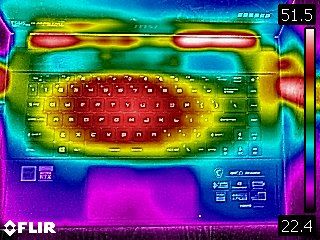
The underside gets hot to the touch. The toastiest point reached 54.6 degrees Celsius (130.3 degrees Fahrenheit).
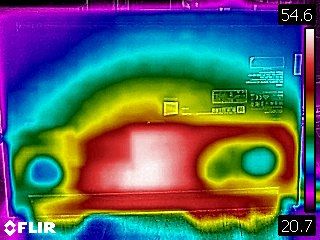
This is also the point where I recommend you play games with a headset. The fans on this whirred incredibly loudly during the stress test.
Webcam
The 720p webcam in the GS66 Stealth’s top bezel is lackluster. It’s color accurate, and caught my bright red shirt in its vivid glory, but the picture is grainy in a very obvious way. If you’re chatting or streaming, you’ll want to consider investing in an external webcam--not that you could likely find one at the moment.
Software and Warranty
MSI includes a lot of software with the GS66 Stealth. Some of it is useful, but some is just taking up space.
The most important offering is MSI Dragon Center, a bit of a catch-all app with CPU and GPU usage monitoring, True Color to adjust the color profiles on the display, performance settings to tweak, system info and links to support. There’s also Killer Control Center to prioritize networking.
There’s a lot of creative software, including Music Maker Jam, AudioDirector, ColorDirector, PhotoDirector 10 Essential and PowerDirector 10 Essential. We see this as bloatware, though, as creatives who choose to use this laptop will likely bring with them the software that they prefer to use. There’s also a trial of Norton LifeLock Security that you’ll probably want to uninstall.
Additionally, MSI has packed in Ultimate Word Games and Sudoku. That’s on top of the bloat in every copy of Windows 10, including Netflix, Hulu, Candy Crush Friends, Farm Heroes Saga, Disney Magic Kingdoms, Spotify and more.
The laptop comes with Windows 10 Pro installed, rather than Windows 10 Home, which most gaming laptops use.
MSI sells the GS66 Stealth with a 1-year warranty.
Configurations
The GS66 Stealth that we reviewed came with an Intel Core i7-10750H CPU, Nvidia GeForce RTX 2080 Super Max-Q GPU, 32GB of DDR4 RAM and a 512GB M.2 PCIe NVMe SSD. It has a 1920 x 1080, 300 Hz screen and costs $2,699.
For $2,999, you can get an Intel Core i9-10980HK, but otherwise the system is identical. And considering how hot our review unit got, you may want to think twice before paying extra for an even higher-clocked (and overclockable) processor.
The cheapest option is $1,599 with an Intel Core i7-10750H CPU, Nvidia GeForce RTX 2060 Super, 512GB M.2 PCIe NVME SSD and a single 16GB stick of DDR4 RAM. Instead of a 300 Hz display, the panel on this model is clocked at “just” 240 Hz.
Bottom Line

On paper, the Stealth is something of a dream machine. It’s thin, attractive, doesn’t scream “gaming” but also has per-key RGB lighting. And it has options for top-of-the-line mobile CPUs and GPUs.
But gaming machines of any size need adequate cooling, and our configuration was clearly struggling in MSI’s chassis. While gaming performance was strong, productivity performance clearly suffered a bit. And in our measurements, the GS66 Stealth offered up hot skin temperatures.
If you’re using your system more for productivity than gaming, the Gigabyte Aero 17 HDR with the newest parts offered better non-gaming scores. If you don’t need as powerful a gaming machine, the cheaper Asus ROG Zephyrus G14 offers amazing CPU performance and battery life, but comes with a lesser RTX 2060 -- and a slightly smaller screen.
When looks and portability are what matter, the Stealth is for you. But you’ll have to live with some performance, noise, and temperature sacrifices to get there.
Andrew E. Freedman is a senior editor at Tom's Hardware focusing on laptops, desktops and gaming. He also keeps up with the latest news. A lover of all things gaming and tech, his previous work has shown up in Tom's Guide, Laptop Mag, Kotaku, PCMag and Complex, among others. Follow him on Threads @FreedmanAE and Mastodon @FreedmanAE.mastodon.social.
-
zarak214 Hey, I noticed you mentioned the heating, does it gets hot more than the GS65? Also if I buy the Base model, is the heating of that gonna be the same? the base model having rtx2060, 240Hz?Reply -
lvjcor a weird CPU comparison - MSI GS66 Stealth (Intel 10750H) vs. Aero 17 (10875H)???? can we get the benchmarks with the same CPU configuration??Reply -
gemini_mouse hello~ IR camera is right there, open the eyesReply
btw, don't just put the products on the floor and took pictures, be professional and get a photographer... -
rileyscott123 okay first thing first if you don't want a camera at least don't pretend it's not there duhh.Reply
And second of all GS66 is paired with 6 cores while Gigabyte is 8. Not entirely sure if this is about bashing the brand you are reviewing or you just simply didn't do enough of your homework)smh -
colorofblue What is the purpose of a fingerprint reader? If it's for Windows Hello, this machine gets a IR camera that supports the function. Is there any other function for a fingerprint? I don't quite understand the reason for this comment.Reply -
colorofblue I'd love to exchange for strong gaming performance for a bit higher temperature. The temperature seems a bit higher but at least the system won't throttle and give me all the power it can gets. That is the point why I would consider to get the laptop with the latest cpu and gpu.Reply
